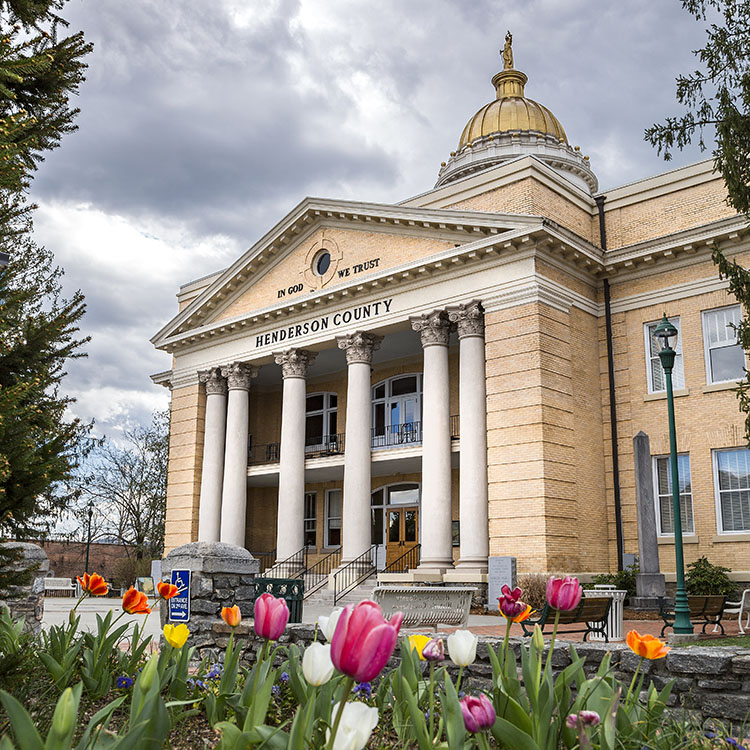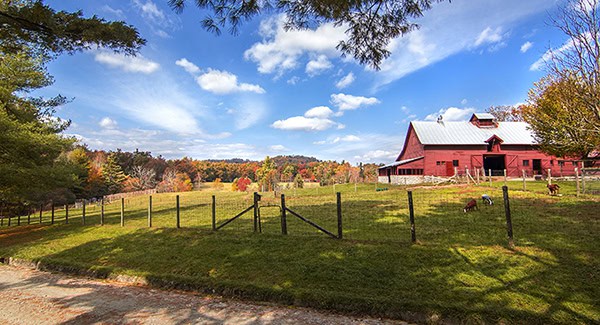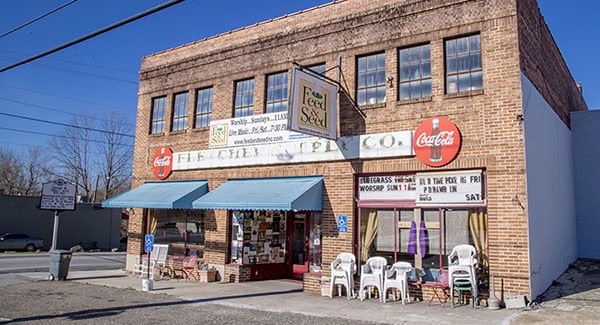Last Updated on June 7, 2023

Main Street, Hendersonville is often called one of the best Main Streets in America. And for good reason!
Since the turn of the century, the town has revitalized its local business scene and advanced its reputation as a place that offers something for just about everyone. You’ll find pubs, restaurants, museums, general and specialty stores, and other independent businesses within just a few steps of each other. But there’s something more you can find if you’re looking for it: Wonderful stories of Hendersonville’s rich history.
Today, we’d like to share the history of Hendersonville with you, as told through several buildings in its Main Street Historic District. But first:
What is Hendersonville’s Main Street Historic District?
Listed on the National Register of Historic Places, the Main Street Historic District encompasses 65 contributing commercial and governmental buildings in the central business district of Hendersonville. Many of these buildings include notable examples of Classical Revival, Neo-Classical, and late Art Moderne architecture. The architecture reflects the prosperity the community experienced during the height of the town’s development during roughly the late 19th and early 20th centuries. The pattern and setback of the district has also only experienced minimal changes since it was laid out in 1841, just three years after Henderson County was created.
The Henderson County Courthouse (1905) is located within the district, and also listed separately in the National Register. Additional notable buildings within the Main Street Historic District include:
- Huggins Building (c. 1850).
- Cole Bank Building (c. 1880).
- Justus Pharmacy.
- Davis Store block (1900).
- The Federal Building (1914).
- Maxwell Store Building (c. 1910).
- Pace’s Market (c. 1925).
- J.C. Penney Building (1939).
1841–1900: Ripley Building (Huggins Building)
During its early years, Hendersonville served primarily as a judicial center and as a stopover on the Buncombe Turnpike. It wasn’t until the railroad came through that the town became a destination in itself. Two buildings survive from the town’s first decade, both built for Colonel Valentine Ripley. Ripley was an early entrepreneur who operated a stagecoach line on the turnpike and owned the town’s first hotel. One brick store building (c. 1850s) at 218 N. Main Street, known as the “Ripley brick store house,” is believed to have served as a Confederate commissary during the Civil War.
The second, called Ripley Building and now known as the Huggins Building, was also built circa 1850 on the corner of Main Street and First Avenue. The two-story coursed ashlar stone commercial building is believed to be the oldest surviving structure on Main Street. A modern storefront was added at some point between existing stone pillars, as were six tall, double-hung windows on the second story (replacing paired casement windows). Still, the Huggins Building stands as its own window back in time to the first years of the town of Hendersonville.
Find the Huggins Building at 101–105 S. Main Street. The building is located on the corner of the block next to Brandy’s on Main.
1900–1910: Henderson County Courthouse
In the first few years of the 20th century, Hendersonville exploded in growth. In 1906, a local paper published an article entitled “Progressive Hendersonville.” The author of the article wrote, “We have grown from a town of about 1200 to about 3000 in the last four years. Most of our buildings are new and of neat and pretty design.”
Among the new buildings in town was a gold-domed, Neo-Classical courthouse. Built between 1904–1905, the building replaced the town’s original stucco structure, but remained on the same site. The architect was Richard Sharp Smith, an Englishman and associate of Richard Norris Hunt. Smith came to the states to work with Hunt, supervising architect of the Biltmore House in Asheville. After Hunt’s death, Smith served as Vanderbilt’s resident architect on the estate. The Henderson County Courthouse is Smith’s only structure in Hendersonville.
The most notable feature of the three story brick courthouse is the gold domed three-stage cupola. The cupola consists of a columned drum and domical roof, crowned by a statue of Lady Justice, believed to be one of only three in the U.S. that are not blindfolded. According to the district’s application to join the National Registry, “On a whole, the relative sophistication and grandeur of the courthouse seems a reflection of the aspirations of a small county seat whose economy was booming and whose population was beginning to soar.”
Find the historic courthouse building at 1 Historic Courthouse Square on the west side of S Main Street, between First and Second Avenues. The Henderson County Heritage Museum is now at the site.
1910–1930: Pace’s Market
With the explosion of growth, Hendersonville saw more money come into town along with the additional residents. Prior to 1900, Hendersonville had only one bank. During the early 20th century, several more were established. Surviving bank structures include the buildings at 421 N. Main, 400 N. Main, and 229 N. Main. The former People’s National Bank, (c. 1910) is unique for its time in Hendersonville because of its use of reinforced concrete construction and a Neo-Classical facade.
Many other buildings were also added to Main Street during this time, though some surviving landmarks have been substantially altered. The Hunter Building (437–451 N. Main Street, c. 1912), originally housed Hunter’s Pharmacy. It was damaged by fire in 1926 and today says “Morey Building” in tinwork on the parapet. The Maxwell Store Building (529 N. Main Street), also known as the Syndicate Building, was built c. 1910 by Maxwell Brown. He operated a “fancy grocery business” from the location for many years, and the building is now home to Mast General Store.
Just up the block was Pace’s Market. Built c. 1925, Pace’s Market operated through the early 1940s, then Ellison’s Market occupied the building through at least the mid-1950s. Today, visitors can walk through the intact original storefront put in place nearly a century ago. Double leaf doors welcome you through the center of the storefront area, and a single door on the south side leads to the second floor.
Find the Pace’s Market building at 620 N. Main Street. The narrow building at the entrance to the downtown corridor is now home to Tripp’s Renovations.
1930–1956: J.C. Penny Building
Development in Hendersonville slowed during the Depression. However, the community experienced renewed growth and development beginning in the late 1930s and continuing through the mid-1950s. After World War II, Hendersonville’s population expanded and there was a need for housing and employment for many of the war veterans. Two churches were built in the 1930s, local schools were expanded greatly through the 1940s, and Pardee Memorial Hospital was dedicated in 1953. In addition, surrounding neighborhoods grew quickly through new construction, including the Hyman Heights/Mount Royal neighborhood and Druid Hills.
Downtown Hendersonville also benefited greatly from this new period of renovation and new construction. Photos from the 1940s to 1950s show a thriving Main Street, with parades, shoppers, bond rallies for war efforts, street dances, and plenty of new store openings. At one point, Main Street had three movie theaters; eight auto service and sales companies; four bakeries; eight barbers; three beauty salons; one bookseller; 21 cafes; four cleaners; eight clothiers; four department stores; five drugstores; two 5 & 10 cent stores; one florist; five furniture stores; nine grocers; two hardware stores; two hotels; two ice cream parlors; two jewelers; two photographers; one printer; and two shoe stores.
Brick buildings with flat roofs were commonly constructed during this period. Built c. 1939, the J.C. Penney Building originally held its namesake department store. The two-story striated brick structure features a concrete cap at the parapet and a facade with a minimal Art Moderne look. The storefront appears to be more or less still the original design from the late 1930s.
Find the J.C. Penney Building at 422 N. Main Street.
Watch Hendersonville, NC build a rich future!
Distinguished by an almost perfect climate, beautiful surroundings, and recreational variety—and surrounded by a sea of majestic mountains!—Hendersonville is known as the City of Four Seasons. The town’s many tranquil neighborhoods and housing developments all surround a sturdy core—a downtown that’s a unique blend of the past and the present. As a place where you can be as active or idle as you wish, Hendersonville has attracted hundreds of families looking for a gentle climate, beautiful scenery, ample recreational facilities, and friendly people.
Does that sound like the perfect lifestyle for you? Search for homes in Hendersonville now!



